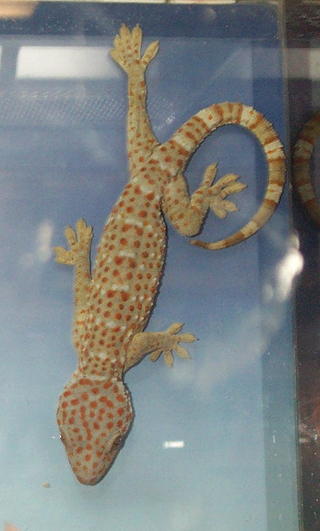
Gekko is a genus of Southeast Asian geckos, commonly known as true geckos or calling geckos, in the family Gekkonidae. Although species such as Gekko gecko are very widespread and common, some species in the same genus have a very small range and are considered rare or endangered.
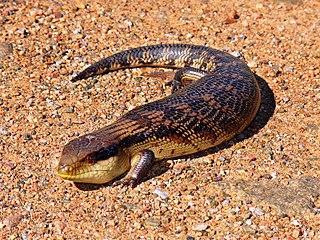
Skinks are lizards belonging to the family Scincidae, a family in the infraorder Scincomorpha. With more than 1,500 described species across 100 different taxonomic genera, the family Scincidae is one of the most diverse families of lizards. Skinks are characterized by their smaller legs in comparison to typical lizards and are found in different habitats except arctic and subarctic regions.

Cyrtodactylus is a diverse genus of Asian geckos, commonly known as bent-toed geckos, bow-fingered geckos, and forest geckos. The genus has 354 described species as of 2023, which makes it the largest of all gecko genera.

Lygosoma is a genus of lizards, commonly known as supple skinks or writhing skinks, which are members of the family Scincidae. Lygosoma is the type genus of the subfamily Lygosominae. The common name, writhing skinks, refers to the way these stubby-legged animals move, snake-like but more slowly and more awkwardly.

Riopa is a genus of skinks. It is easy to tell the species apart from most other skinks by bright red coloring on their sides from which they get their name. They also have a bule that runs down the side of their tail.
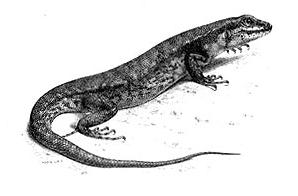
The genus Sphenomorphus – vernacularly also known as the common skinks – currently serves as a "wastebin taxon" for numerous skinks. While most or all species presently placed here are probably rather close relatives, the genus as presently delimited is likely to be not monophyletic and is in need of review. Some species in this genus have been moved to Pinoyscincus.

Dibamus is a genus of legless lizards in the family Dibamidae.

Subdoluseps bowringii, also known commonly as Bowring's supple skink, Bowring's writhing skink, and the Christmas Island grass-skink, is a species of lizard in the subfamily Lygosominae of the family Scincidae. The species is native to Southeast Asia.
Subdoluseps pruthi, known commonly as Pruthi's skink or Pruthi's supple skink, is a species of diurnal, terrestrial, insectivorous, lizard in the family Scincidae. The species is endemic to the southern part of the Eastern Ghats in South India. The species was first described based on the type specimen from Chitteri hills in Dharmapuri district of Tamil Nadu. Further surveys reveal the presence of similar-looking skinks in nearby hill ranges. Though described in 1977, the holotype was collected in 1929, and yet very little is known or has been published about this species.
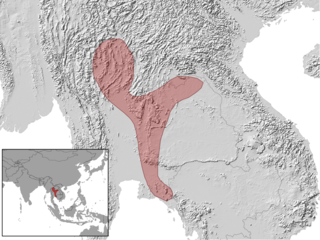
The banded supple skink, also known commonly as Harold's writhing skink and Harold Young's supple skink, is a species of lizard in the family Scincidae. The species is endemic to Southeast Asia.
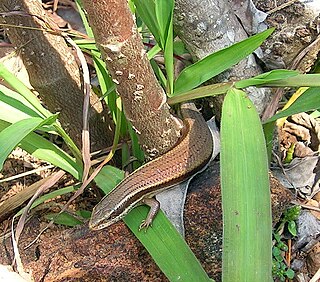
Lygosominae is the largest subfamily of skinks in the family Scincidae. The subfamily can be divided into a number of genus groups. If the rarely used taxonomic rank of infrafamily is employed, the genus groups would be designated as such, but such a move would require a formal description according to the ICZN standards.

The fire skink, also known commonly as Fernand's skink, the Togo fire skink, and the true fire skink, is a fairly large skink, a species of lizard in the family Scincidae. The species is known for its bright and vivid coloration. Native to tropical forests in West and Central Africa, the fire skink lives fifteen to twenty years. This species is a diurnal lizard that burrows and hides. It is relatively shy and reclusive, but may become tame in captivity.

Eutropis is a genus of skinks belonging to the subfamily Mabuyinae. For long, this genus was included in the "wastebin taxon" Mabuya; it contains the Asian mabuyas. They often share their habitat with the related common skinks (Sphenomorphus), but they do not compete significantly as their ecological niches differ. This genus also contains the only member of the subfamily to occur in Australasia, the many-lined sun skink, whose wide range includes New Guinea.

Tytthoscincus is a genus of skinks. Originally defined to include a few species from the Philippines, the genus now includes many species from South-East Asia in general.
Lygosoma bampfyldei, commonly known as Bampfylde's supple skink or Bampfylde's writhing skink, is a species of lizard in the subfamily Lygosominae of the family Scincidae. The species is endemic to Malaysia.
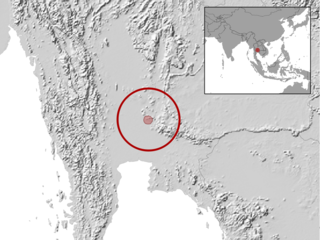
Taylor's writhing skink or pygmy supple skink is a species of skink found in Thailand.
Herbert's supple skink, also known commonly as Herbert's writhing skink is a species of lizard in the subfamily Lygosominae of the family Scincidae. The species is native to Malaysia and Thailand.
Lygosoma schneideri, also known commonly as Schneider's writhing skink and the Sumatran supple skink, is a species of lizard in the family Scincidae. The species is endemic to Indonesia.
The Nilgiri gracile skink is a species of skink found in Western Ghats ranges in the Nilgiri hills in Tamil Nadu, South India.
Dravidoseps is a genus of skinks, found in Southern India. They were all previously found in the genera Subdoluseps & Riopa.













